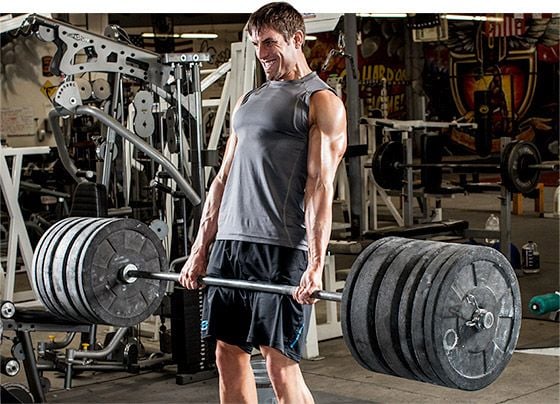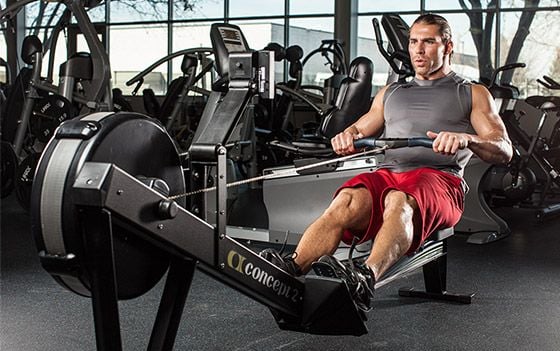Table of Contents
Are you one of the people who avoid cardio training because of fear of losing all their well-deserved muscles? See how science speaks about this issue!
“Cardio kills muscle” has long been a sort of mantra in the fitness community. Some bodybuilders cling to this notion so hard that they think they will turn into a weakling because of the regular stairs. It is true that muscle adaptation varies greatly depending on the type of training. There is a difference between strengthening and aerobic training.
The more you practice one type of training, the harder it will be to achieve the same level in the other. Compare marathon runner and Kai Green.

But that doesn’t mean that cardio and weight training are totally incompatible. If you set up your workouts correctly, cardio can help improve your results, body composition and general health.
CAN YOU DO CARDIO AND GROW YOUR MUSCLE?
A few decades ago, it was found that 10 weeks of cardio workouts along with strength training had a negative impact on muscle mass growth, compared to strength training alone. /1/ However, if we take a closer look at the volume training used in this study – 6 days a week of cardio training and 5 days a week of strength training – we can infer that it was pretty hard. Only a few of us will perform 30 to 40-minute cardio six days a week.
However, recent research suggests that an adequate amount of cardio can indeed increase the effects of strength training. Studies have shown that weight training in combination with 2-3 days of cardio may result in greater muscle mass growth than strength training alone. /2,3/

What to take from it? It seems that the golden middle way is a combination of cardio and weight training. Too much cardio workout can limit muscle growth, but too little cardio can limit muscle growth. Performing cardio 2-3 days a week seems to be the right choice for lean muscle growth without putting your muscles at risk.
ORDER IS IMPORTANT
Muscle adaptation in both aerobic and endurance workouts can potentially cross and overlap, so it is very important to allow enough time between workouts to minimise this phenomenon, optimise performance, as well as subsequent adaptation. /4,5/
Strength disabilities followed by high intensity or endurance exercises can last up to 6 hours, so it makes more sense to separate training sessions for at least such a long time. /2,6,7/
On the other hand, if you wait too long, you may start experiencing pain from your earlier training. This is because muscle pain has a delayed onset. Try to find the golden way: long enough after the previous workout, but well before the onset of muscle pain (especially from the lower body workout) that will not affect the quality of your workout.

When it comes to the order, it does not have to radically affect muscle growth. Several studies have examined adaptation in weight training before aerobic training or vice-versa and found that improvement in muscle strength and size was not affected by the training order. /8,9/
From a practical point of view, it is likely that tiredness from strength training will have less impact on cardio training than vice versa. Think about it. Would you rather be tired after 3 reps of squats or a 3-mile run? We’d better take the other one. Everybody is different. Experiment with the order and timing of your workouts to see what fits you better and brings benefits to your performance.
THE WAY MATTERS
Compared to other forms of cardio, running can cause lots of muscle damage, most likely due to a large amount of eccentric muscle contractions during movement. However, cycling places more emphasis on concentric muscle activity. This can cause less overall damage and ultimately reduce the amount of overlap with muscle renewal and growth.

Hours of running are probably not the best idea, but activities like cycling can improve your gym results. Several studies have shown that weight training in combination with cycling can increase muscle mass more than weight training in combination with a treadmill, or more than just weight training alone. /3,10/
WHAT TO TAKE OUT OF IT?
Cardiovascular exercise offers some significant health benefits, including improved aerobic capacity. But it also provides benefits when lifting weights. Cardio can give you more work capacity during exercise in the gym, allow faster recovery between workouts, improve your body composition, and essentially keep you from collapse when you have to climb several steps. The timing and overall volume of cardio and weight training seem to be the main factor in designing successful and concurrent training programs.
TRY CARDIO TO SUPPORT MUSCLE MASS GROWTH
• Adopt strategies that increase cardio but minimise the total amount of workouts (eg HIIT 2-3 times a week).
• From a practical point of view, performing cardio before training with weights can have a more positive effect on your performance and quality of training than vice versa.
• Separate these workouts with a minimum of 6-hour break to optimise your results.
• Cycling provides more benefits than running when it comes to muscle mass growth.

HOW TO INCORPORATE CARDIO WITH WEIGHT TRAINING
SAMPLE TRAINING PLAN 1
• Monday morning: Bottom parts
• Monday afternoon: Stationary bike 8-10 sets for 1 minute (in a mode of crazy workout and then last 10-15 seconds of this interval when you are gasping for breath), with a 1-minute pause. Start with a 5-minute warm-up and finish by cooling down for 5 minutes.
• Tuesday: Upper parts – pressures
• Wednesday: Off
• Thursday morning: Bottom parts
• Thursday afternoon: Stationary bicycle for about 15 km consistently (Finish 15 km as fast as you can and aim for daily improvement)
• Friday: Upper parts – pull-ups

SAMPLE TRAINING PLAN 2
• Monday: Upper parts – pressures
• Tuesday: Upper parts – príťahy
• Wednesday morning: Bottom parts
• Wednesday afternoon: Stationary bicycle for about 15 km in one pace (Strive for the highest intensity for the whole 30 minutes)
• Thursday: Off
• Friday: Upper parts – pressures
• Saturday: Upper parts – pull-ups
• Sunday morning: Bottom parts
• Sunday afternoon: Rowing machine 6-8 sets about 400 meters as fast as you can, then 200 meters of recovery. (Start by warming up for 5 minutes and then cooling down for 5 minutes)

Taken from bodybuilding.com
Sources:
1. Hickson, R. C. (1980). Interference of strength development by simultaneously training for strength and endurance. European Journal of Applied Physiology and Occupational Physiology, 45(2-3), 255-263.
2. Lundberg, T. R., Fernandez-Gonzalo, R., Gustafsson, T., & Tesch, P. A. (2013). Aerobic exercise does not compromise muscle hypertrophy response to short-term resistance training. Journal of Applied Physiology, 114(1), 81-89.
3. Mikkola, J., Rusko, H., Izquierdo, M., Gorostiaga, E. M., & Häkkinen, K. (2012). Neuromuscular and cardiovascular adaptations during concurrent strength and endurance training in untrained men.International Journal of Sports Medicine, 33(9), 702-710.
4. Sale, D. G., MacDougall, J. D., Jacobs, I., & Garner, S. (1990). Interaction between concurrent strength and endurance training. Journal of Applied Physiology, 68(1), 260-270.
5. Baar, K. (2014). Using molecular biology to maximize concurrent training. Sports Medicine, 44(2), 117-125.
Häkkinen, K., Alen, M., Kraemer, W. J., Gorostiaga, E., Izquierdo, M., Rusko, H., … & Romu, S. (2003). Neuromuscular adaptations during concurrent strength and endurance training versus strength training.European Journal of Applied Physiology, 89(1), 42-52.
6. Bell, G. J., Petersen, S. R., Wessel, J., Bagnall, K., & Quinney, H. A. (1991). Physiological adaptations to concurrent endurance training and low velocity resistance training. International Journal of Sports Medicine, 12(4), 384-390.
7. Eklund, D., Schumann, M., Kraemer, W. J., Izquierdo, M., Taipale, R. S., & Häkkinen, K. (2016). Acute endocrine and force responses and long-term adaptations to same-session combined strength and endurance training in women. The Journal of Strength & Conditioning Research, 30(1), 164-175.
8. Cadore, E. L., Izquierdo, M., dos Santos, M. G., Martins, J. B., Lhullier, F. L. R., Pinto, R. S., … & Kruel, L. F. M. (2012). Hormonal responses to concurrent strength and endurance training with different exercise orders.The Journal of Strength & Conditioning Research, 26(12), 3281-3288.
9. Gergley, J.C., (2009). Comparison of two lower-body modes of endurance training on lower-body strength development while concurrently training. Journal of Strength & Conditioning Research, 23(3), 979-987.

